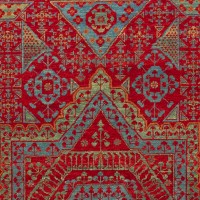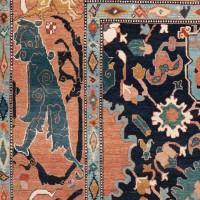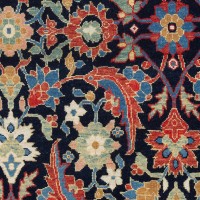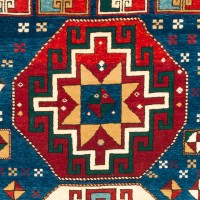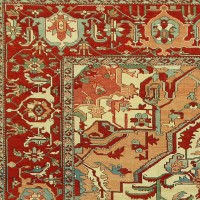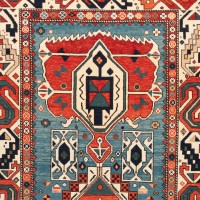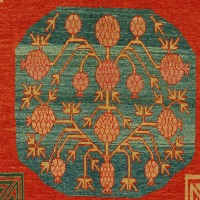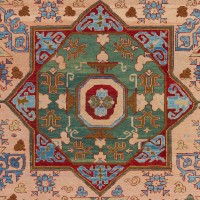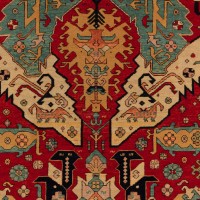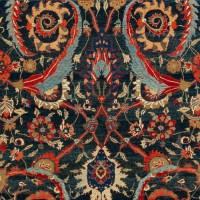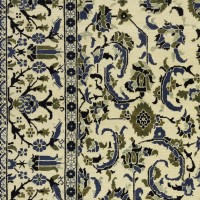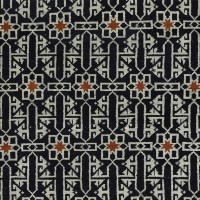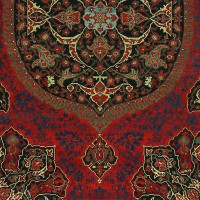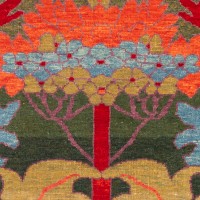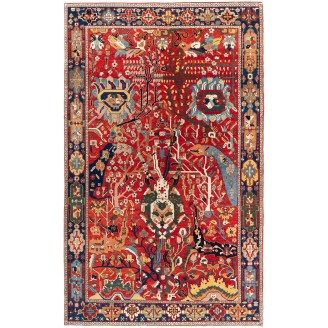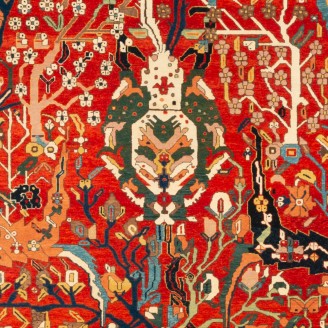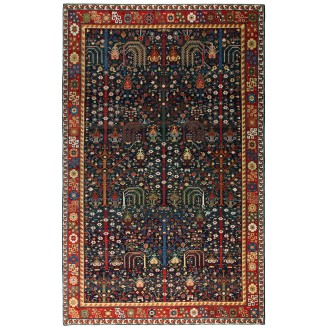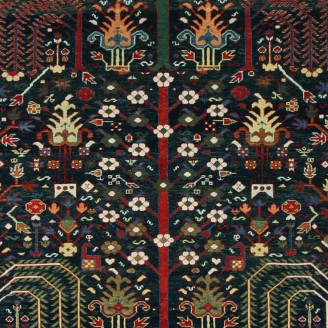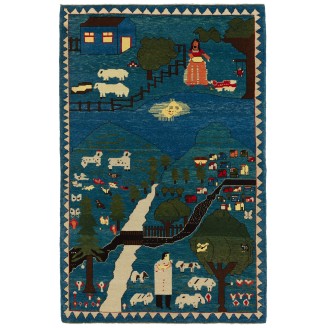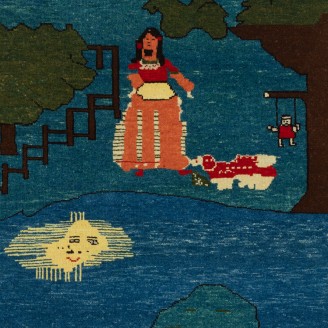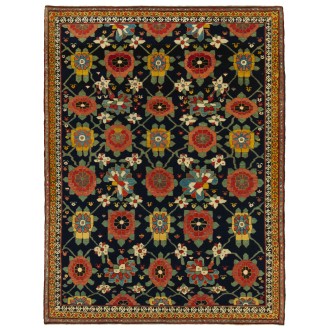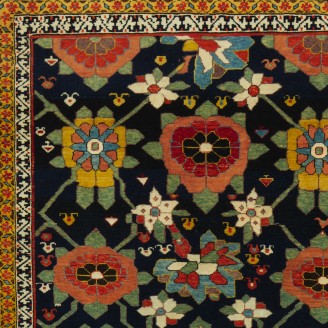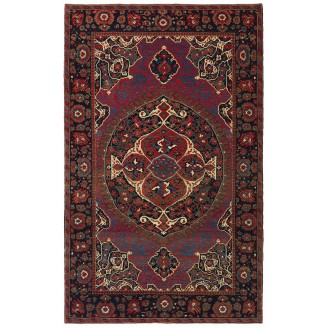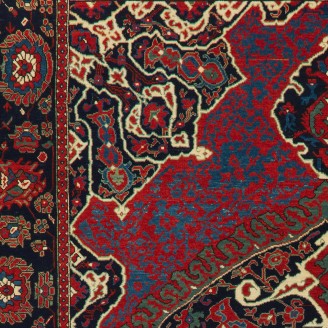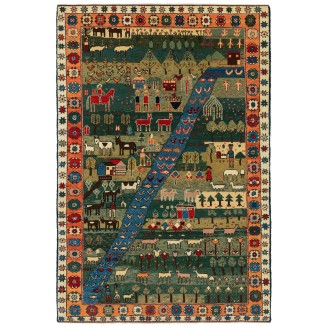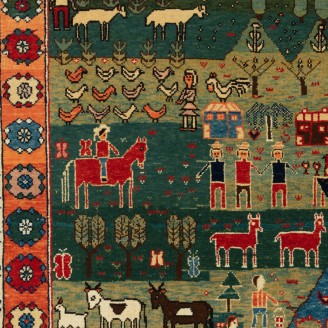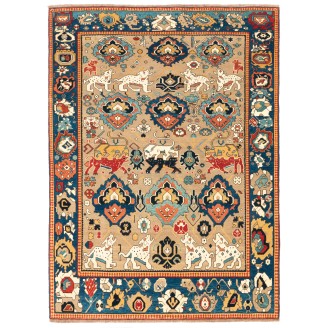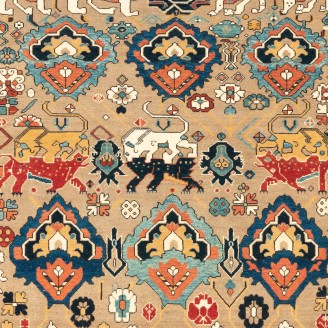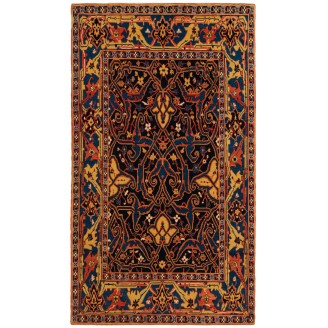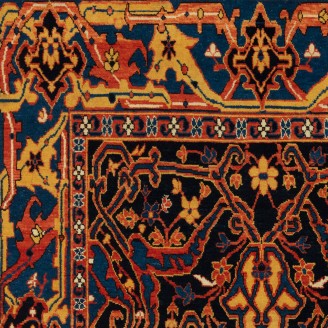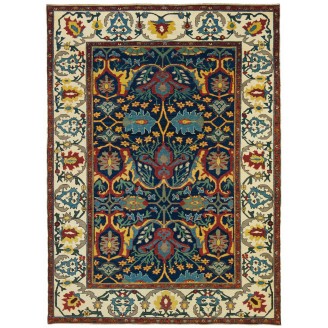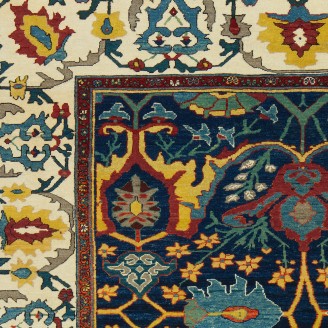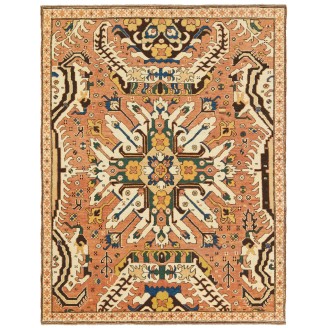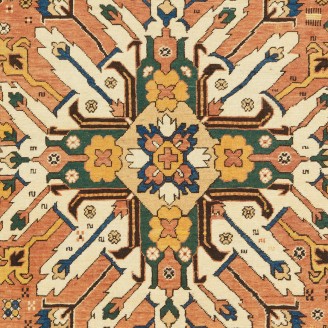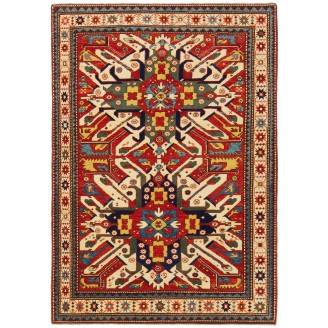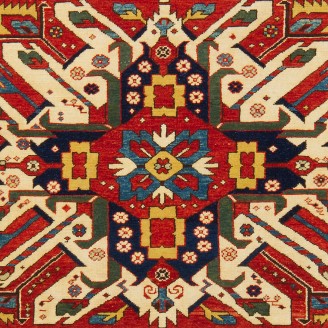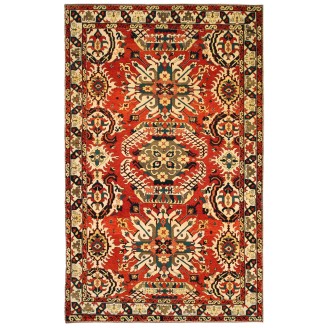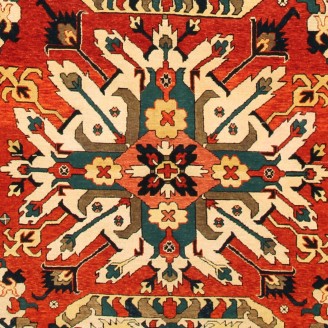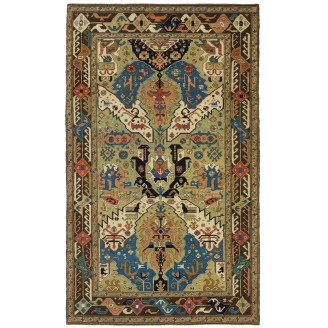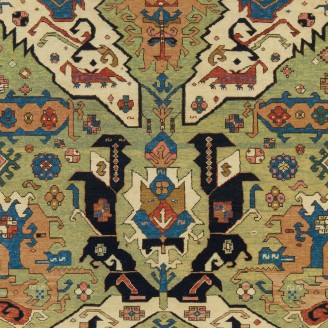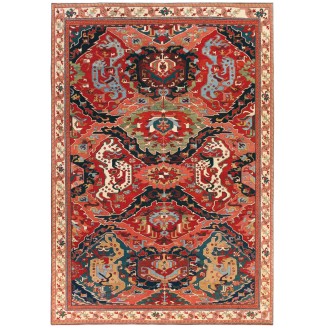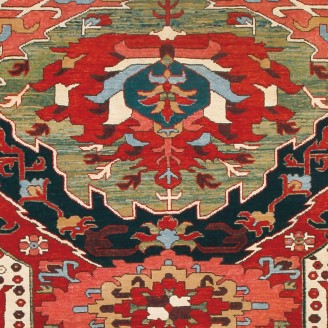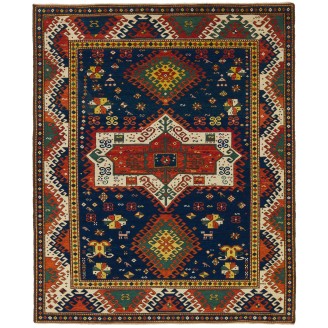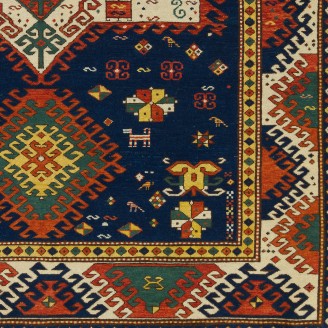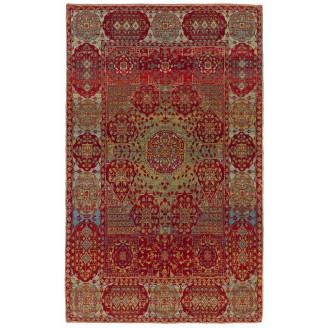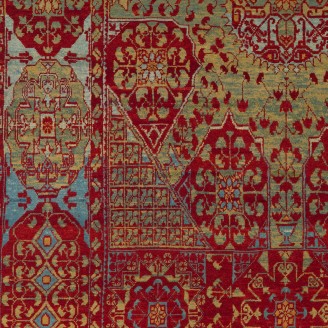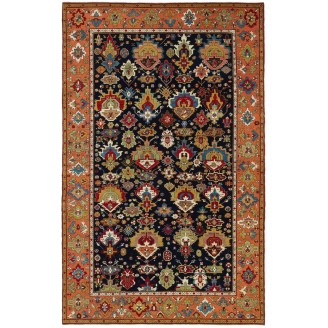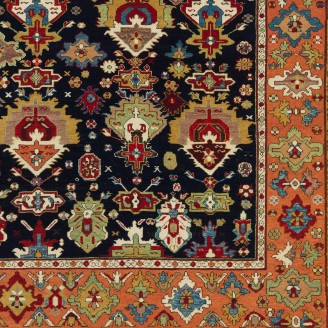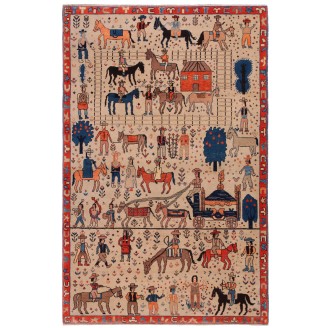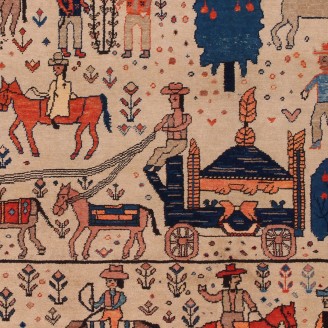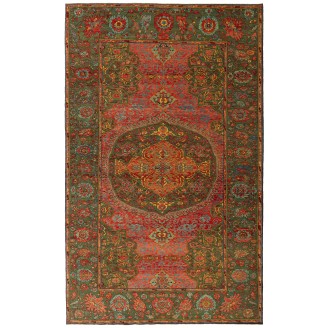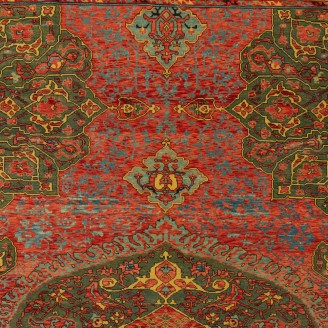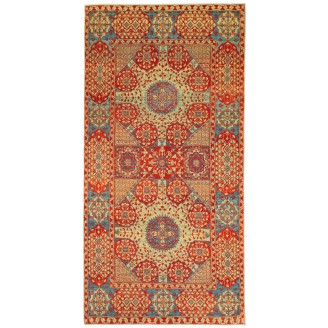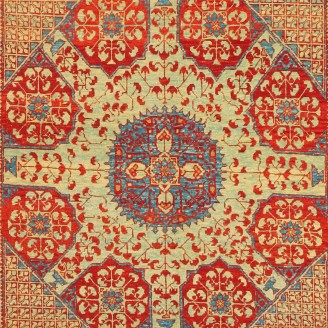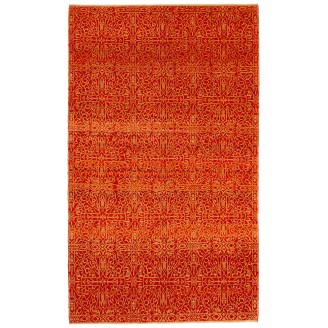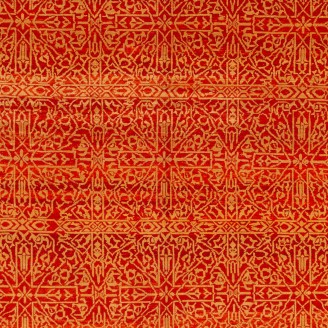Model: ART00227
Dimensions: 6'11" X 11'8"(213cm x 358cm)
The source of the carpet comes from the book The Kevorkoff Carpet, Hali Magazine 1994 Issue 73. This is a large and brilliantly colored, derivation from a vase carpet, an 18th-century rug from the North-west Persia area. As mentioned in the Hali magazine article by Ian Bennett, the original size is ..
Price:
$22,000
Ex Tax:$22,000
Model: ART00268
Dimensions: 7'7" X 12'1"(233cm x 369cm)
The source of the rug comes from the book Antique Rugs of Kurdistan A Historical Legacy of Woven Art, James D. Burns, 2002 nr.45. This is a popular design employed by the Kurds, called bid majnum (or Bid Majnun, weeping willow) 17th-century rug from Sa'uj Bulagh, Eastern Kurdistan area. Four differe..
Price:
$23,000
Ex Tax:$23,000
Model: ART00600
Dimensions: 4'3" X 6'7"(132cm x 202cm)
This unique design rug is interpreted by our designers with a composition of pictorial village life. Color summary: 9 colors in total; Jericho Jade 25 (Spurge - Indigo) Lucario Blue 342 (Spurge - Madder Root - Indigo) Misty Moss 14 (Spurge - Madder Root) Russian Green 418 (Henna - Indigo..
Price:
$4,650
Ex Tax:$4,650
Model: ART00509
Dimensions: 5'6" X 7'3"(170cm x 222cm)
The source of the rug comes from the book Antique Rugs of Kurdistan A Historical Legacy of Woven Art, James D. Burns, 2002 nr.4. This was an exclusive example of a Mina Khani lattice design mid-19th century rug from Koliya'i, Southern Kurdistan area. The mina khani is composed of a series of rows of..
Price:
$8,200
Ex Tax:$8,200
Model: ART00606
Dimensions: 10'4" X 6'5"(317cm x 198cm)
The source of the carpet comes from the book How to Read – Islamic Carpets, Walter B. Denny, The Metropolitan Museum of Art, New York 2014 fig.58 and Antique Rugs from the Near East, Wilhelm von Bode and Ernst Kühnel, Klinkhardt & Biermann, Berlin 1958, pg.40 and Orienta..
Price:
$19,500
Ex Tax:$19,500
Model: ART00567
Dimensions: 4'5" X 6'7"(137cm x 202cm)
This unique design rug is interpreted by our designers with a composition of pictorial village life. Color summary: 11 colors in total; Yellow Green 419 (Henna - Indigo) Pine Tree 420 (Henna - Indigo) Natural Wool Color 320 (Specially Washed) Fiery Orange 6 (Madder Root) Ginger Church 1..
Price:
$4,250
Ex Tax:$4,250
Model: ART00322
Dimensions: 4'11" X 6'8"(150cm x 204cm)
The source of the carpet comes from the book Orient Star - A Carpet Collection, E. Heinrich Kirchheim, Hali Publications Ltd, 1993 nr.81. This is an example of one of the most intriguing design groups of carpets from the Caucasus and North-west Persia area, and surrounding regions 17th to 18th centu..
Price:
$5,700
Ex Tax:$5,700
Model: ART00588
Dimensions: 4'11" X 8'6"(150cm x 260cm)
The source of the rug comes from the book Antique Rugs of Kurdistan A Historical Legacy of Woven Art, James D. Burns, 2002 nr.33. This is a fine Kurdish workshop rug with split-palmette and trefoil arabesque patterns designed mid-19th century rug from Senna or Garrus, Eastern Kurdistan area. This de..
Price:
$7,650
Ex Tax:$7,650
Model: ART00531
Dimensions: 5'9" X 7'10"(177cm x 240cm)
This is a Bidjar rug designed in the 19th century from the Bidjar region, also known as Bijar, which is a region in northwestern Iran known for producing some of the finest and most durable rugs in the world. During the 19th century, Bidjar rugs gained prominence and were in high demand. They were f..
Price:
$9,300
Ex Tax:$9,300
Model: ART00393
Dimensions: 4'2" X 5'4"(127cm x 163cm)
The source of the rug comes from the book Oriental Rugs Volume 1 Caucasian, Ian Bennett, Oriental Textile Press, Aberdeen 1993, nr.87-88-90. This is a large medallion rug from the late 19th century, Karabakh, Chelaberd region ( Tchelaberd, a village slightly to the southeast of Chondzoresk ), Caucas..
Price:
$3,800
Ex Tax:$3,800
Model: ART00434
Dimensions: 4'7" X 6'6"(140cm x 199cm)
The design source of the rug comes from the book Tapis du Caucase - Rugs of the Caucasus, Ian Bennett & Aziz Bassoul, The Nicholas Sursock Museum, Beirut, Lebanon 2003, nr.29 and Oriental Rugs Volume 1 Caucasian, Ian Bennett, Oriental Textile Press, Aberdeen 1993, nr.93 and Caucasian Carpets, E...
Price:
$3,200
Ex Tax:$3,200
Model: ART00138
Dimensions: 6'5" X 10'4"(198cm x 315cm)
The source of the rug comes from the book Caucasian Carpets, E. Gans-Reudin, Thames and Hudson, Switzerland 1986, pg.57. This is a large medallion rug from the late 19th century, Karabakh, Chelaberd region ( Tchelaberd, a village slightly to the southeast of Chondzoresk ), Caucasus area. At Chelaber..
Price:
$12,600
Ex Tax:$12,600
Model: ART00472
Dimensions: 5'7" X 9'3"(172cm x 283cm)
There has long been a fascination with the symbolism of the dragon and its depiction in carpet weavings. The design of ‘Dragon’ carpets consists of a field pattern composed of different colored overlaid lattices formed of pointed, serrated leaves creating intersecting lozenges, which alternately con..
Price:
$9,300
Ex Tax:$9,300
Model: ART00044
Dimensions: 8'4" X 12'2"(255cm x 372cm)
The source of the rug comes from the book Orient Star - A Carpet Collection, E. Heinrich Kirchheim, Hali Publications Ltd, 1993 nr.57. There has long been a fascination with the symbolism of the dragon and its depiction in carpet weavings. The design of ‘Dragon’ carpets consists of a field pattern c..
Price:
$28,300
Ex Tax:$28,300
Model: ART00497
Dimensions: 6'2" X 7'5"(188cm x 227cm)
This is another Kazak example of the Fachralo is a town north of Lori-Pambak and just southwest of Bordjalou, from the late 19th century, Caucasus area. It has given its name to a number of usually small, boldly designed, and brilliantly colored Kazak rugs but, although this has proved a useful desc..
Price:
$4,900
Ex Tax:$4,900
Model: ART00586
Dimensions: 7'6" X 4'8"(231cm x 143cm)
The source of the rug comes from the book Renaissance of Islam, Art of the Mamluks, Esin Atil, Smithsonian Institution Press, Washington D.C., 1981 nr.125. This a rug with a cup motif design, a late 15th-century rug from Mamluk Sultane of Cairo, Egypt. It is exhibited at the Washington D.C. The..
Price:
$6,600
Ex Tax:$6,600
Model: ART00445
Dimensions: 5'10" X 9'3"(179cm x 282cm)
The source of the rug comes from the book Orient Star - A Carpet Collection, E. Heinrich Kirchheim, Hali Publications Ltd, 1993 nr.75. This offset pattern is composed of ascending shield-like palmettes flanked by leaf-like wings designed for 17th to 18th-century rugs from Azerbaijan, the North-west ..
Price:
$11,000
Ex Tax:$11,000
Model: ART00183
Dimensions: 5'1" X 7'10"(156cm x 240cm)
This unique design rug is interpreted by our designers with a composition of pictorial western-style life.Color summary: 17 colors in total, most used 4 colors are; Misty Moss 14 (Spurge - Madder Root) Scarlet 5 (Madder Root) Dark Brown 316 (No Dye - Sheep’s own Color) Jericho Jade 25 (Spurge ..
Price:
$4,800
Ex Tax:$4,800
Model: ART00599
Dimensions: 8'0" X 13'2"(245cm x 402cm)
The source of the carpet comes from the book How to Read – Islamic Carpets, Walter B. Denny, The Metropolitan Museum of Art, New York 2014 fig.58 and Antique Rugs from the Near East, Wilhelm von Bode and Ernst Kühnel, Klinkhardt & Biermann, Berlin 1958, pg.40 and Oriental Carpets in the Museum o..
Price:
$29,800
Ex Tax:$29,800
Model: ART00144
Dimensions: 4'10" X 9'10"(149cm x 300cm)
The source of the rug comes from the book Renaissance of Islam, Art of the Mamluks, Esin Atil, Smithsonian Institution Press, Washington D.C., 1981 nr.125. This a rug with a cup motif design late 15th-century rug from Mamluk Sultane of Cairo, Egypt. It is exhibited at the Washington D.C. The Textile..
Price:
$7,700
Ex Tax:$7,700
Model: ART00180
Dimensions: 5'2" X 8'9"(160cm x 268cm)
This rug has an interpreted design composed of a geometric lattice pattern taken from a part of the Mamluk rug, filling the field elegantly, has the impression that it is only part of a larger scheme designed 15th-century rug from the Mamluk era, Cairo region, Eygpt. Mamluk carpets originated in a p..
Price:
$7,400
Ex Tax:$7,400
